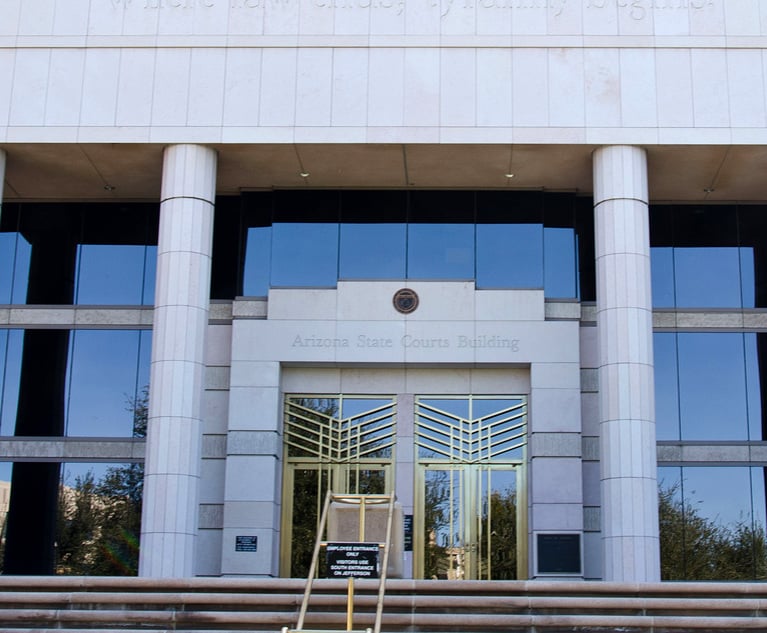Friends in high places - the controversies dogging the SEC
"If the SEC gave JP Morgan a pass because it was doing the Government a favour by taking over Bear Stearns in a crisis, then it should come out and say so. Otherwise, it is hard to understand why the SEC never brought this case..."
April 19, 2012 at 07:03 PM
7 minute read
Claims that the SEC gives special treatment to connected individuals continue to dog the US markets regulator. Susan Beck reports
Call it reverse accountability. In the wake of the financial crisis, the US Securities and Exchange Commission (SEC) has often been criticised for failing to charge any top executives when it sues a big institution. But one case stands out as an exception. In February, the SEC announced it would settle fraud charges against Ralph Cioffi (pictured left) and Matthew Tannin (pictured right), the former Bear Stearns hedge fund managers who oversaw a 2008 implosion of their funds that led to $1.6bn (£1bn) in investor losses.
In a deal that was announced on the day their civil trial was set to begin, the two men agreed to pay a total of $1.05m (£660,000). But their employer – Bear Stearns Asset Management, now owned by JP Morgan Chase – was never charged.
The SEC declined to explain this decision. The result can partly be understood when viewed in the context of the extraordinary events that led JP Morgan to acquire Bear Stearns at the US Government's urging over a frenzied weekend in March 2008. But it still raises questions about how decisions are made at the agency.
In this case, before the acquisition, JP Morgan's general counsel Stephen Cutler contacted then enforcement director Linda Thomsen with a bold request. Cutler, a former SEC director of enforcement who had been Thomsen's boss, tried to get her to ensure that JP Morgan wouldn't be sued for Bear Stearns' misdeeds. Although Thomsen, who is now a partner at Davis Polk & Wardwell, did not give Cutler exactly what he wanted, she did take the unusual step of giving some vague assurances in writing, which upset some of her staff who were investigating Bear Stearns.
This prompted an anonymous complaint to the SEC's inspector general, who documented these events in a 2009 report. Then inspector general David Kotz found no evidence that Cutler got special treatment or that Thomsen's letter to JP Morgan caused the SEC to abandon its investigations into Bear Stearns. But he did find that these events fuelled a perception within SEC ranks that connected people get special treatment. And the fact remains that the SEC never did file charges against Bear Stearns.
Why revisit these events four years later? Because the contention that lawyers with the right contacts get special treatment continues to dog the agency. Just last September, Kotz issued another report addressing allegations that current enforcement director Robert Khuzami went easy on two Citigroup executives because he's friendly with one of Citigroup's outside lawyers. (The Inspector general exonerated Khuzami.)
So as the SEC appears to be winding down its case against Cioffi and Tannin (at press time the settlement needed court approval), it is worth asking once again why the agency never charged the company they worked for.
Back in 2008, as JP Morgan was pressured to rush through a deal to pick up the battered Bear Stearns, Cutler contacted Thomsen on Saturday 15 March on her mobile phone. The bank general counsel was concerned about JP Morgan inheriting Bear Stearns' regulatory liabilities. At the time, the SEC's investigation into Bear Stearns' hedge fund losses was the most active subprime investigation in the enforcement division, according to Kotz's report.
In her interview with Kotz, Thomsen said that she did not view Cutler's request for assurance as outrageous, given the extraordinary circumstances. But Brian Cartwright, who was then general counsel of the SEC, was troubled by this request and by Thomsen's reaction. He testified that Thomsen initially said she was comfortable giving Cutler this assurance.
"I think almost anybody at the SEC would find it very difficult to swallow the notion that we would give a pass for past violations of the securities laws," he said, according to the IG's report. "That's just something we don't normally do." Cartwright also pointed out that critics might dwell on Cutler and Thomsen's relationship.
The next day, a Sunday, Thomsen emailed a letter to JP Morgan chief executive Jamie Dimon. It did not contain any promises, but it did state that the relevant factors weighed against recommending an action based on statements made by Bear Stearns in the prior 60 days. Cutler testified that he was disappointed with Thomsen's response. "I remember thinking, okay, this is better than a poke in the eye with a sharp stick," he told the inspector general. "But, you know, I didn't get what I would have like to have gotten." Through a company spokesman, Cutler declined to comment.
In an interview, Cartwright says he viewed this letter as nothing more than "window dressing". He explains: "It was written in an attempt to minimise any friction resulting from our failure to grant their requests, but all the letter said is that we'd do what we normally do." (Cartwright is currently a scholar in residence at the Marshall School of Business of the University of Southern California.)
Thomsen did not notify anyone in the enforcement division before she sent this letter, according to the report, although she did tell other division leaders. That angered her deputy, Walter Ricciardi, who told the inspector general that his exclusion from these communications was one reason he left the agency. (Neither Thomsen nor Ricciardi, who is now a partner at Paul Weiss Rifkind Wharton & Garrison, responded to requests for comment.)
What impact did Thomsen's letter have on the SEC's enforcement efforts? The agency's lawyers gave Kotz differing accounts about the signals they received. Some said they got the message to ease off, while others said they didn't. Thomsen told Kotz she was surprised if anyone thought they should not pursue their investigation. Former general counsel Cartwright, who left the agency in 2009, says he does not recall ever learning what happened to the investigation.
Three months after these events, the SEC brought charges against Cioffi and Tannin, but has never charged Bear Stearns Asset Management. (The SEC declined to comment about the potential for future investigations.)
The SEC considers various factors when it decides whether to charge a company whose employees have been accused of wrongdoing, including the company's co-operation and remedial steps taken. In this instance the SEC also had to contend with the fact that Cioffi and Tannin were acquitted in their 2009 criminal trials for alleged securities fraud, which might have weighed against holding JP Morgan liable.
Private plaintiffs, on the other hand, have had some success attempting to hold JP Morgan responsible for Bear Stearns' hedge fund activities. Bank of America, Barclays and hedge funds investors have all filed suits. The Barclays case settled for an undisclosed amount, and an investors' case settled for $19m (£11.9m). Bank of America's suit against Bear Stearns Asset Management has survived a motion to dismiss, as have other investor cases.
If the SEC gave JP Morgan a pass because it was doing the Government a favour by taking over Bear Stearns in a crisis, then it should come out and say so. Otherwise, it is hard to understand why the SEC never brought this case.
This article first appeared in The American Lawyer, a US affiliate title of Legal Week.
This content has been archived. It is available through our partners, LexisNexis® and Bloomberg Law.
To view this content, please continue to their sites.
Not a Lexis Subscriber?
Subscribe Now
Not a Bloomberg Law Subscriber?
Subscribe Now
NOT FOR REPRINT
© 2025 ALM Global, LLC, All Rights Reserved. Request academic re-use from www.copyright.com. All other uses, submit a request to [email protected]. For more information visit Asset & Logo Licensing.
You Might Like
View All
KPMG's Bid To Practice Law in US On Hold As Arizona Court Exercises Caution

Law Firms 'Struggling' With Partner Pay Segmentation, as Top Rainmakers Bring In More Revenue
5 minute read
Trending Stories
- 1Exits Leave American Airlines, SiriusXM, Spotify Searching for New Legal Chiefs
- 2Etsy App Infringes on Storage, Retrieval Patents, New Suit Claims
- 3The Secret Prior Art Problem Rears Its Ugly Head
- 4Four Things to Know About Florida’s New Law to Protect Minors Online
- 5US Supreme Court Considers Further Narrowing of Federal Fraud Statutes
Who Got The Work
J. Brugh Lower of Gibbons has entered an appearance for industrial equipment supplier Devco Corporation in a pending trademark infringement lawsuit. The suit, accusing the defendant of selling knock-off Graco products, was filed Dec. 18 in New Jersey District Court by Rivkin Radler on behalf of Graco Inc. and Graco Minnesota. The case, assigned to U.S. District Judge Zahid N. Quraishi, is 3:24-cv-11294, Graco Inc. et al v. Devco Corporation.
Who Got The Work
Rebecca Maller-Stein and Kent A. Yalowitz of Arnold & Porter Kaye Scholer have entered their appearances for Hanaco Venture Capital and its executives, Lior Prosor and David Frankel, in a pending securities lawsuit. The action, filed on Dec. 24 in New York Southern District Court by Zell, Aron & Co. on behalf of Goldeneye Advisors, accuses the defendants of negligently and fraudulently managing the plaintiff's $1 million investment. The case, assigned to U.S. District Judge Vernon S. Broderick, is 1:24-cv-09918, Goldeneye Advisors, LLC v. Hanaco Venture Capital, Ltd. et al.
Who Got The Work
Attorneys from A&O Shearman has stepped in as defense counsel for Toronto-Dominion Bank and other defendants in a pending securities class action. The suit, filed Dec. 11 in New York Southern District Court by Bleichmar Fonti & Auld, accuses the defendants of concealing the bank's 'pervasive' deficiencies in regards to its compliance with the Bank Secrecy Act and the quality of its anti-money laundering controls. The case, assigned to U.S. District Judge Arun Subramanian, is 1:24-cv-09445, Gonzalez v. The Toronto-Dominion Bank et al.
Who Got The Work
Crown Castle International, a Pennsylvania company providing shared communications infrastructure, has turned to Luke D. Wolf of Gordon Rees Scully Mansukhani to fend off a pending breach-of-contract lawsuit. The court action, filed Nov. 25 in Michigan Eastern District Court by Hooper Hathaway PC on behalf of The Town Residences LLC, accuses Crown Castle of failing to transfer approximately $30,000 in utility payments from T-Mobile in breach of a roof-top lease and assignment agreement. The case, assigned to U.S. District Judge Susan K. Declercq, is 2:24-cv-13131, The Town Residences LLC v. T-Mobile US, Inc. et al.
Who Got The Work
Wilfred P. Coronato and Daniel M. Schwartz of McCarter & English have stepped in as defense counsel to Electrolux Home Products Inc. in a pending product liability lawsuit. The court action, filed Nov. 26 in New York Eastern District Court by Poulos Lopiccolo PC and Nagel Rice LLP on behalf of David Stern, alleges that the defendant's refrigerators’ drawers and shelving repeatedly break and fall apart within months after purchase. The case, assigned to U.S. District Judge Joan M. Azrack, is 2:24-cv-08204, Stern v. Electrolux Home Products, Inc.
Featured Firms
Law Offices of Gary Martin Hays & Associates, P.C.
(470) 294-1674
Law Offices of Mark E. Salomone
(857) 444-6468
Smith & Hassler
(713) 739-1250









